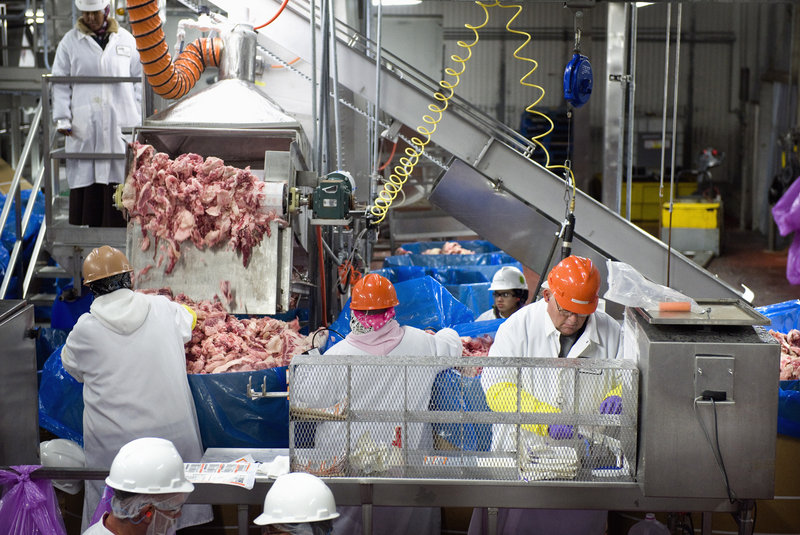FORT MORGAN, Colo. – Amid the cattle carcasses zipping down the disassembly line and the herd of workers wielding the sharpest of knives, there’s a war going on each day at Cargill Inc.’s sprawling beef plant on the northeastern Colorado plains.
It’s a fight against E. coli, potentially lethal bacteria behind several big disease outbreaks and food recalls in recent years. It’s fought with technology, lab testing and a phalanx of safety inspectors, and it may soon involve a pioneering vaccine that cuts E. coli risks before cattle even arrive at the slaughterhouse.
Cargill’s — and for that matter the meat industry’s — ultimate goal: Never repeat the experience of Stephanie Smith.
She is the young Cold Spring, Minn., dance instructor who lost the use of her legs, bowel and bladder in 2007 after eating a Cargill-made hamburger tainted with E. coli O157:H7. The highly publicized Smith case highlighted the human consequences of even one safety slip-up.
Big food recalls and disease outbreaks can also cost a company tens of millions of dollars while tainting a firm’s reputation. It’s a critical issue for Cargill, a global food colossus that is based in Minnetonka, Minn.
A recent survey conducted for National Public Radio found that 61 percent of Americans were worried about contamination of their food supply, with meat the top concern.
“I’ve interacted with people who’ve had foodborne illnesses, and it is a terrible and painful thing for them and their families,” said Nicole Johnson-Hoffman, general manager of Cargill’s Fort Morgan plant and a lawyer who worked on the Smith case. “We need to keep these people in mind when we do our job.”
Yet for all the effort to contain E. coli, the fight seems to get only tougher, as evidenced by an August recall from a Cargill meat plant in Pennsylvania. It was a relatively minor one as recalls go. But it involved a strain of E. coli — O26 — that had not previously been associated with meat that got people sick.
The Centers for Disease Control and Prevention estimates that 73,000 people get sick each year from E. coli O157:H7. The transmission of the bacteria to people is simple: through feces. With one mistake at the slaughterhouse, a microscopic piece of cattle dung can make its way onto an animal’s carcass and into a finished beef product — though proper cooking will kill it.
E. coli O157:H7 surfaced as a major public health issue in 1993, when an outbreak linked to Jack in the Box restaurants killed four children and sickened hundreds of people.
“It was the meat industry’s (Sept. 11, 2001),” said Bill Marler, a Seattle food-safety attorney who has represented Smith and other foodborne illness victims in suits against Cargill. “It really galvanized the industry to pay attention to O157.”
Over the past two years, the number of recalls due to E. coli contamination has declined, after skyrocketing in 2007. In that year, for reasons that aren’t clear, the number of E. coli-related recalls jumped to 21, from just eight the year before, according to data from Marler, the attorney, based on federal statistics.
The damage was widespread in the meat industry. In October 2007, Cargill recalled about 845,000 pounds of hamburger patties made at its Butler, Wis., operation.
The recall was connected to an E. coli O157:57 outbreak in several states, including some cases of hemolytic uremic syndrome (HUS), the worst outcome of E. coli O157:H7 poisoning. Along with the usual fever, chills and diarrhea, HUS can involve kidney failure.
That’s what happened to Smith, then age 20, who was in a coma for two months and hospitalized for six more. She sued Cargill for $100 million, plus medical costs, and the two sides settled in May. Terms weren’t disclosed, but Cargill agreed to cover Smith’s care for life. Her plight was featured in a New York Times investigation that won a Pulitzer Prize this year.
“The Stephanie Smith case was a tragic reminder of the criticality of what we do every day to protect people from foodborne illness,” said Johnson-Hoffman, general manager of the Fort Morgan plant.
The ground beef supply chain is particularly critical to meat safety, and not surprisingly most meat-related E. coli outbreaks stem from ground beef. its nature, ground beef is potentially more of a safety hazard since it’s made up of trimmings — scraps of meat and fat — from the carcasses of several cattle, not just one animal.
Plus, ground beef operations like Cargill’s in Butler, Wis., get their meat from several sources. So, for all the precautions Cargill might take with its own slaughtering process, it can’t be totally sure of its suppliers’ procedures.
Cargill’s safety requirements for its ground beef suppliers were criticized in the Times investigation, though the company said it has since made its standards more stringent.
Send questions/comments to the editors.



Success. Please wait for the page to reload. If the page does not reload within 5 seconds, please refresh the page.
Enter your email and password to access comments.
Hi, to comment on stories you must . This profile is in addition to your subscription and website login.
Already have a commenting profile? .
Invalid username/password.
Please check your email to confirm and complete your registration.
Only subscribers are eligible to post comments. Please subscribe or login first for digital access. Here’s why.
Use the form below to reset your password. When you've submitted your account email, we will send an email with a reset code.